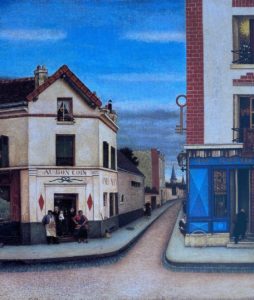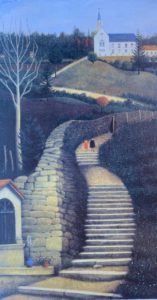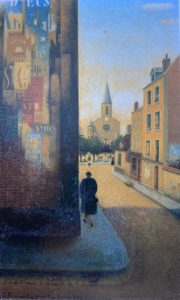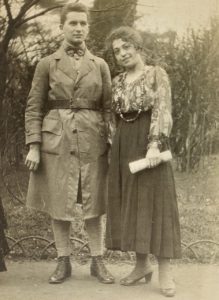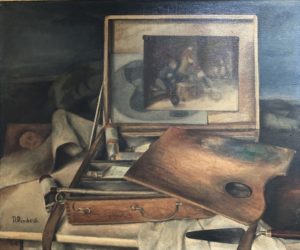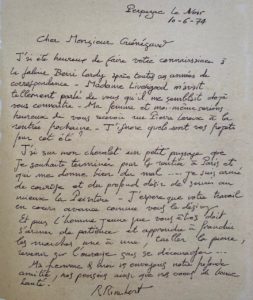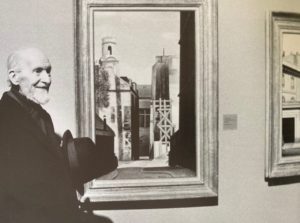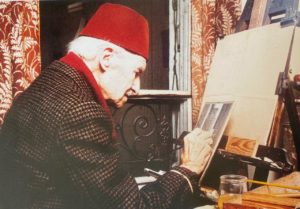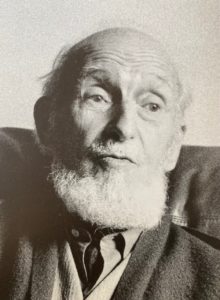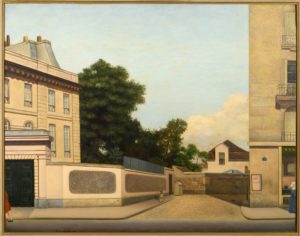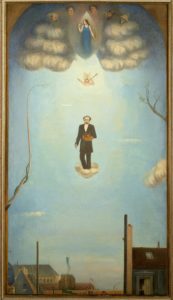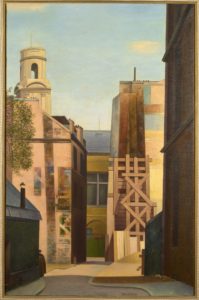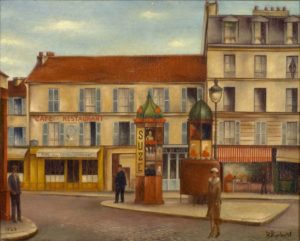It was in 1974 during a retrospective that Mrs Livengood from the Berri-Lardy gallery « physically » introduced me to Rene Rimbert with whom I had been conversing for many years, a systematic correspondence. One hundred and thirteen letters were exchanged before the meeting, letters to which he had always responded with kindness and simplicity. I was never to forget that evening in March 1974 !.. In fact during our correspondence Rimbert regularly spoke to me about « his Russian friend » he had known for almost fifty years, the Russian men friend with whom he often wandered the streets of Paris, while talking about their mutual passions : philosophy, spirituality, music and of course painting. This Russian friend was Serge Charchoune to whom he introduced me in turn this 19th March 1974. I had no idea at the time that that date would remain forever etched on my memory, that these two meetings would turn my life upside down, trigger passions and that one day I would write about the two great twentieth century artists. son ami russe » qu’il connaît depuis presque cinquante ans, cet ami russe avec lequel il se promène souvent dans les rues de Paris, tout en parlant de leurs passions communes : la philosophie, la spiritualité, la musique et la peinture bien sûr. Cet ami russe, c’est Serge Charchoune à qui il me présente à son tour ce 19 mars 1974. Je ne me doutais pas alors que cette date resterait à jamais gravée dans ma mémoire, que ces deux rencontres allaient bouleverser ma vie, déclencher des passions et qu’un jour j’écrirais sur ces deux grands artistes du vingtième siècle.
Despite the great age difference, Rimbert was 78 years old, Charchoune 86, when I was going to be 25 the following month, we very quickly got on well together. No doubt this was thanks to the great modesty of the two men and their natural ability to bring themselves within reach of the youg man I was at the time. I was never to see Charchoune again. Already ill, he died the following year. Some time later, however, I visited Rimbert in his home, rue Pierre Leroux behind the store « Le Bon Marché ». In the small appartment reigned, just as the artist’s paintings, the same atmosphere of serenity, harmony, inaccessible timelessness. René Rimbert also bathed in an inner light, his blue eyes starting at the clouds like the blue sky of this paintings. That day, I promised Rimbert to Write, as soon as possible, a book on his work and organize a retrospective of his paintings in a prestigious location. Le Bon Marché. Il régnait dans le petit appartement, comme dans les toiles de l’artiste une même atmosphère de sérénité, d’harmonie, d’intemporalité inaccessible. René Rimbert, lui aussi, baignait dans une lumière intérieure, le regard bleu dans les nuages comme le bleu du ciel de ses peintures. Je fis à Rimbert ce jour-là, la promesse d’écrire dès que possible un livre sur son œuvre et d’organiser une rétrospective de ses peintures dans un lieu prestigieux.
A few months later I met Dina Vierny, a rare personality who would also mean a lot to me, a great lady of painting. Former model of Maillol and Matisse, an unusual character, she had known, the greatest artists of the twentieth century, frequented post-war literary and artistic circles, Dina had just organized an exhibition in Japan around le Douanier Rousseau, with, two paintings from Rimbert among others shed id not know personally, but whose paintings she appreciated.
During lunch at the Brasserie Lipp on the boulevard Saint-Germain, I defended the idea of an exhibition in her gallery on rue Jacob. Dina gave me her consent provided I found her paintings from different eras in the artist’s production, to let the public get a global view of Rimbert’s work.
I was delighted and literally « flying » on my way home.I, who, was not originaly from this closed environment of Parisian galleries, had met within a few months Crystel Livengood, René Rimbert, Serge Charchoune and Dina Vierny. I could not believe it and immediately started to work. Dina Vierny, from that moment on, took me under her wing and made me look at painting from a different perspective, taught me a lot about being an art dealer and an expert. I owe her a lot. I believe we could have worked together more, but she had two sons of may age and it was up to them, and not up to me, to be at her sides. So I contented myself in regularly finding paintings for her in France an abroad. On these occasions we always glady me over lunch or at her home, rue de Grenelle, and we talked for hours and hours. Her recent death has caused me very much sorrow and filled me with great sadness, having the feeling of losing a second mother as well as a great friend. Olivier, her eldest son, took over the Maillol Museum brilliantly, I am happy for her, and her work continues thanks to him.
I was therefore searching for paintings for this exibition project at the Dina Vierny gallery. The exhibition finally held in November 1983 with a beautiful catalogue. On the opening night, on precisely 22nd November 1983, Rimbert was delighted. deeply moved, he signed the exhibition catalogue with the same kindness and modesty, with a pleasant word for everyone. He walked pass each of his old and new paintings, making comments on every painting as if he were discovering them for the first time, sometimes satisfied, sometimes very critical. The paintings had crossed the century, the works of 1922, 1935, 1950, 1980 had the same uniqueness, the same grasp. Anyone who could gige the date of a painting was very clever, as they all had the same quality, « the same grasp », reaching perfection. The paintings had crossed the twentieth century without a wrinkle, always with the same freshness. la même tenue », atteignait la perfection. Les peintures avaient traversé le XXème siècle sans une ride, avec toujours la même fraîcheur.
We were in the presence of an unconsciously cabalistic work, carrying a hidden message addressed to the viewer. Each of these paintings was packed with skill, craftsmanship, a mysterious relationship was instated between the painting and its viewer. These empty streets, serene landscapes stopped in time exude a mysterious absence, an unexpected vision of simplicity. Rimbert’s paintings are mesmerizing and all the whilegiving themselves to the viewer, they oblige the viewer to sensitively ask reflexive questions and to question the mystery of existence.
René Rimbert en ce soir de vernissage apparut inaccessible, il semblait baigner dans un rayonnement intérieur, dans un univers dans lequel on devait être initié, dans lequel surtout les impatients n’avaient pas de place. Cet univers faisait cependant l’unanimité de l’émotion.
A few words now on René Rimbert…
René Rimbert was born in Paris on 20th September 1896. He had a problem-free, his family quickly moving to the left bank of the Seine, where his father worked as a gilder-framer. He soon started to draw and tred painting. One of his uncles gave him a box of oil paints, a box of colours that he kept all his life. It was at the age of 19 only, in 1915, that he painted his first oil painting.
René married Denise in 1919 . They went to Denise’s village Perpezac-le-Noir for their honneymoon, a village that the artist painted so often later one. It was the end of the war. The young couple both re-joined the postal administration.
The following year, in 1920, Rimbert enrolled in a workshop to perfect his skills in drawing and in the complex technique of oil painting ; the Colarossi Academy, rue de la Grande Chaumière in the neighbourhood of Montparnasse. He presented one of his paintings for the first time at the Salon des Indépendants, and on this occasion he met the painter Marcel Gromaire who became both his adviser and friend.
René Rimbert’s first paintings and especially his still lifes are very much influenced by Cubism and by Cézanne. In 1922, he sold his first painting : Violin and Mandolin from 1921, number 30 of the catalogue raisonné, during the Salon des Indépendants. The same year, René Rimbert made another important encouter, the poet Max Jacob. Le violon et la mandoline de 1921, n° 30 du catalogue raisonné, durant le Salon des Indépendants. Toujours la même année René Rimbert fait une autre rencontre importante, celle du poète Max Jacob.
A lasting friendship was established between the two men over the years and encounters. As from this year of 1922, twenty years of numerous encounters and correspondences between the two men elapsed.
In 1924, based on the advice from Marcel Gromaire and Max Jacob, René Rimbert entered the Percier gallery, and consequently met : the owner André Level, and the director, René Mendès-France, and Serge Charchoune another painter who became his friend and with whom he shared his love for music, his passion for philosophy and theosophy. André Level became the first big art dealer . He sold several of his paintings, encouraged him, and organized his first important individual exhibition. Max Jacob wrote the foreword of the exhibition leaflet. It was a great success.
Picasso, another artist who frequented the gallery encouraged him. Rimbert discovered le Douanier Rousseau thanks to Max Jacob and Picasso. He was « carried away » by this persona and Rimbert decided to paint, in 1926, a painting in his honour : Le Douanier Rousseau rising the glory and entering posterity dans la postérité, number 85 of the catalogue raisonné of René Rimbert’s paintings, with a full-page reproduction in the catalogue on page 48.
« Picasso saw the painting on Rousseau at my exhibition at the Percier gallery and it made hime laugh tremendously, being a friend of the painter of his paintings….Finally it was Mr Wildenstien, a great collector of works of art acquired in 1937 »
Painting was not enough for René Rimbert. His interest in the esoteric, symbolism, and pilosophy grew. He also participed in the masonic circles.
Between 1929 and 1930, he painted several paintings that can be considered as major. The house of mystery, View of the city called also The open window and The still Life with game of card, all three now in the Maillol Museum in Paris. The economic crisis of 1929 hit the art market world, several galleries closed, many artists suffered. The years passed with great difficulty, the crisis deepened, the Popular Front in France gradually transformed society.
It was not until 1937 that a major exhibition was finally held : « The Popular Masters of Reality ». populaires de la RéalitéHenri Rousseau, Camille Bombois, Séraphine Louis and René Rimbert participated with twelve paintings. The exhinition was held not only in Paris, but also in Switzerland and several cities in the United States. This was the first time that Rimbert exhibited abroad. The war broke in 1939, Rimbert did not take out his paintbrushes, not until the end of the hostilities. In 1944, his friend Max Jacob was arrested.
At the end of the war René Rimbert became successful, he returned to painting. Several exhibitions in France and abroad, ensued. Certainly, he produced little, his demand for high qualiti meant that his paintings were created in dribs and drabs. He was not intoxicated by success and created quitly, at a pace that was own. Every year, between four and twelve paintings took shape. He was finally able to devote all his time and mind to painting. In 1955, he retired from the postal administration. Henry Certigny, very famous art critic, wrote him several letters to encourage him.
In 1964, it was the turn of the Berri-Lardy gallery to pay tribute to him. This exhibition was once again a huge success. In 1965, René Rimbert participated with two paintings,in a major exhibition in Tokyo about le Douanier Rousseau. Between 1966 and 1972 several international exhibitions for René Rimbert were held : Japan once again, then London, Belgium, Yugoslavia, Czechoslovakia, Norway and Denmark. Autour du Douanier Rousseau.
En 1974, Mrs Livengood organized a retrospective with thirty-eight paintings. This exhibition of his paintings was again a success, as well that already mentioned in 1983 at the Dina Vierny gallery.
1983 unfortunately ended with health problems for my artist friend. His eyesight declined, he decided with sadness but with reason to stop painting. He left Paris to retire with Denise, his wife, in their village Perpeza-le-Noir. I went to see them the following summer, finding them both tired, they were struggling to move around and sat inside the little house to enjoy the cool wall. Eimbert tried to read, but his eyesight failed him. « I can’t even read what is left for me ? » . I took his hand, I was sad for my old friend. Denise was going a little senile and often repeated the same questions…he wa slightly irritated with her…then tenderness returned, he smiled gently back and the old lady’s eyes lit up. However, the end of the road was nigh, the boat would soon join the harbour… Il faut laisser le temps au temps ». Quarante ans plus tôt son ami Max Jacob avait dit à propos de l’ancien postier : « Il a la patience qui donne l’amour… et le courage qui retient l’amour dans les filets de la discrétion. »
1983 unfortunately ended with health problems for my artist friend. His eyesight declined, he decided with sadness but with reason to stop painting. He left Paris to retire with Denise, his wife, in their village Perpeza-le-Noir. I went to see them the following summer, finding them both tired, they were struggling to move around and sat inside the little house to enjoy the cool wall. Eimbert tried to read, but his eyesight failed him. « I can’t even read what is left for me ? ». I took his hand, I was sad for my old friend. Denise was going a little senile and often repeated the same questions…he wa slightly irritated with her…then tenderness returned, he smiled gently back and the old lady’s eyes lit up. However, the end of the road was nigh, the boat would soon join the harbour…
Since they were find it difficult to preserve their autonomy, they decided by mutual agreement to go into a nursing home. They had a common room, side by side, as always, to peacefully await the end. Denise died first and a few months later, on 23rd March 1991 René Rimbert met, in turn, his final initiation.

